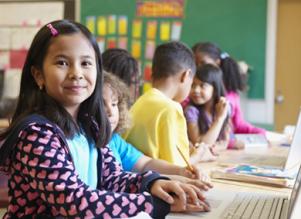7/9/2017
Blended Learning 101: Know the Basics
Blended learning is an instructional methodology that leverages technology to provide a more personalized approach to learning, giving students control over the time, place, path, and pace of their learning.
The Clayton Christensen Institute, one of the most well-known thought leaders on blended learning, defines the approach as a formal education program in which the student learns partly through online learning and partly in a supervised brick-and-mortar location away from home. The modalities along each student’s learning path within a course or subject are connected to provide an integrated learning experience.
According to the Christensen Institute, there are four models that are most commonly implemented in schools today:
-
Rotation Model
This approach entails students working in a number of different activities (or centers), including whole-group instruction, small-group instruction, peer-to-peer activities, pencil-and-paper assignments, and individual work on a computer or tablet. According to EdSurge.com, this model is essentially halfway between a traditional classroom approach and an entirely virtual experience. Students rotate on a fixed schedule between learning online in a one-to-one, self-paced environment and spending time with a teacher or otherwise having a traditional classroom experience. Within the rotation model, there are several different implementation settings:
-
Station rotation
Similar to the classroom center rotation, students work through a circuit of activities in the classroom (or classrooms) during one or more class periods, with at least one of these activities involving instruction via technology.
-
Individual rotation
Students work through some or all of the classroom centers based on an individualized prescription determined by the teacher with the help of a technology-driven assessment tool.
-
Lab rotation
Students work on individualized, online instruction in a computer lab. Then, typically, the teacher will use data from students’ progress in the lab session to inform whole- or small-group instruction in the classroom.
-
Flipped classroom
Students receive the primary instruction (similar to the whole-group instruction) in the form of online learning outside of the school day. The core lesson is provided via technology as “homework,” and then students apply the skill through assignments and projects during class time with the teacher’s support.
-
Flex Model
In the Flex Model, students learn on-site in a brick-and-mortar setting using an online instructional tool as the backbone of the course or subject, with the teacher providing support as necessary. Students’ instructional paths are customized and fluid, and the depth, frequency, and manner of teacher support can vary based on each school’s implementation model. According to Global Personalized Academics, an innovative education company that provides virtual and classroom learning solutions to schools around the world, "The flex model is the Grand Poobah of blended learning and schools who take it on must be totally and completely committed, with all the right materials and spaces to implement it effectively."
-
A La Carte Model
In the A La Carte Model, students receive instruction in a particular course or courses entirely online. In the A La Carte Model, teacher support is provided via an online instructor who is not located at the students' brick-and-mortar school or learning center. This model is gaining popularity in high schools because it increases options by giving students the opportunity to take classes beyond what is already offered at their school.
-
Enriched Virtual Model
In the Enriched Virtual Model, students are required to have face-to-face learning sessions with their teacher but then complete the rest of their coursework remotely, outside of the brick-and-mortar school. Although students may not meet with their instructor on a daily basis, there are formal, regularly scheduled instructional sessions (unlike optional office hours).
A growing number of schools are piloting or implementing blended learning programs, but many educators are unfamiliar with the different aspects of this approach and how the various implementation models of blended learning differ. Technology-laden terms like “one-to-one” and “flipped learning” make blended learning an intriguing—if not daunting—endeavor. However, the foundation of blended learning remains firmly rooted in the concept of empowering teachers to provide personalized and mastery-based instruction.


